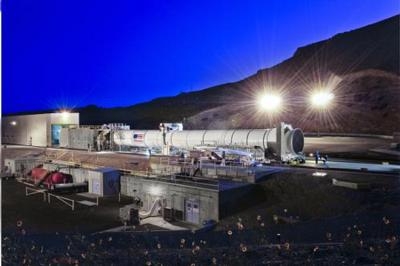Fri, Aug 08, 2014
NASA And ATK Say They Are On Schedule For 2017 Launch
ATK has successfully completed its Critical Design Review (CDR) with NASA to verify that the five-segment solid rocket booster is on track for an unmanned, first flight of NASA's Space Launch System (SLS) in 2017. The SLS vehicle is planned to launch humans deeper into space than ever before.

"Achieving this milestone is a tremendous accomplishment for ATK and NASA as we continue building the boosters for America's Space Launch System," said Charlie Precourt, vice president and general manager of ATK's Space Launch division. "Deep space exploration requires a heavy lift vehicle, and SLS is the only vehicle with the mass, volume and speed required for human missions to destinations such as the moon, an asteroid or Mars."
With the successful completion of CDR, the SLS booster design can now proceed toward qualification testing. Booster avionics qualification efforts are also in work and will be incorporated into the vehicle qualification effort that is scheduled for completion in 2016.
"ATK's technology innovation, process improvements and lean manufacturing will enable SLS to deliver humans and cargo to deep space faster, safer and more affordably than any other existing or planned vehicle," said Precourt, who is also a four-time space shuttle astronaut. "It is exciting to see that the teams working on SLS and the Orion crew capsule are all making steady progress toward NASA achieving a human mission to Mars by the 2030s."
A ground static firing of the full-scale booster, Qualification Motor-1 (QM-1), is planned for late this year/early next year at ATK's facility in Promontory, Utah. The next major booster milestone will be the Design Certification Review scheduled for fall of 2016.
Other upcoming SLS and Orion program milestones include a firing of the modified RS-25 engine this fall and the opening of the SLS Vertical Assembly Center, which is where the rocket's core stage fuel tanks will be welded. Orion's first flight, scheduled for December 2014, will be the farthest a human-rated spacecraft has traveled into space in more than 40 years.
(Image provided by ATK)
More News
He Attempted To Restart The Engine Three Times. On The Third Restart Attempt, He Noticed That Flames Were Coming Out From The Right Wing Near The Fuel Cap Analysis: The pilot repor>[...]
Make Sure You NEVER Miss A New Story From Aero-News Network Do you ever feel like you never see posts from a certain person or page on Facebook or Instagram? Here’s how you c>[...]
From 2009 (YouTube Edition): Leading Air Show Performers Give Their Best Advice for Newcomers On December 6th through December 9th, the Paris Las Vegas Hotel hosted over 1,500 air >[...]
Aero Linx: NASA ASRS ASRS captures confidential reports, analyzes the resulting aviation safety data, and disseminates vital information to the aviation community. The ASRS is an i>[...]
“For our inaugural Pylon Racing Seminar in Roswell, we were thrilled to certify 60 pilots across our six closed-course pylon race classes. Not only did this year’s PRS >[...]
 NTSB Final Report: Rutan Long-EZ
NTSB Final Report: Rutan Long-EZ ANN FAQ: Turn On Post Notifications
ANN FAQ: Turn On Post Notifications Classic Aero-TV: ICAS Perspectives - Advice for New Air Show Performers
Classic Aero-TV: ICAS Perspectives - Advice for New Air Show Performers ANN's Daily Aero-Linx (06.28.25)
ANN's Daily Aero-Linx (06.28.25) Aero-News: Quote of the Day (06.28.25)
Aero-News: Quote of the Day (06.28.25)



